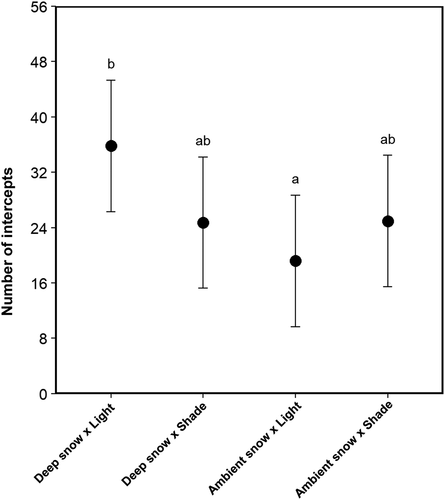Figures & data
Figure 1. Representation of one of the nine blocks in the experiment testing the effect of light attenuation and increased snow cover on the quantity and quality of caribou summer forage. The plot on the right is under increased snow cover (50–75 cm) created by a 1-m high snow fence while the plot on the left is under ambient snow cover (5–20 cm). The dark grey subplot is exposed to 60% shaded light while the white subplot is exposed to ambient light. We estimated biomass in the interception area and sampled vegetation for chemical analyses in the sampling area

Table 1. Summary of the ANOVA used to test the effects of light attenuation and snow accumulation on chemical components of B. glandulosa and Carex spp. in the summer 2018 at Deception Bay, Nunavik (Québec, Canada). ANOVAs include subplots (light treatment) nested in main plots (snow treatment) nested in blocks as a random intercept. The degrees of freedom (df) of the numerator (num) and denominator (den) and the effect of snow treatment (S), light treatment (L), and sampling period (P) on each chemical component are shown. Degrees of freedom for foliar biomass are in parentheses, as there were five sampling periods for this variable
Figure 2. Leaf nitrogen concentration (%) and 95% confidence intervals throughout summer 2018 for (a) Betula glandulosa and (b) Carex spp. for shaded (n = 18) and ambient light (n = 18) plots in the arctic tundra at Deception Bay, Nunavik, Canada. The analysis was performed using a linear mixed model with blocks (n = 9) and all interactions involving blocks as random factors. Predictions that share a common letter are not significantly different (Protected lsmeans, α = 0.05)
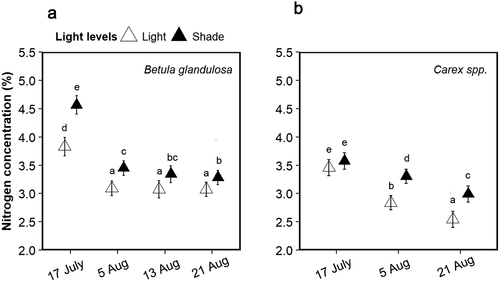
Figure 3. Total phenolic concentration (mg Gallic Acid Equivalent/g) and 95% confidence intervals throughout summer 2018 for Betula glandulosa for (a) shaded (n = 18) and ambient light (n = 18) plots and for (b) deep snow (n = 18) and ambient snow depth plots (n = 18) in the arctic tundra at Deception Bay, Nunavik, Canada. The analysis was performed using a linear mixed model with blocks (n = 9) and all interactions involving blocks as random factors. Predictions that share a common letter are not significantly different (Protected lsmeans, α = 0.05)
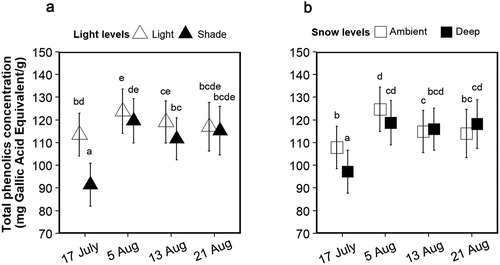
Figure 4. Acid detergent fibre (ADF) concentration (%) and 95% confidence intervals throughout summer 2018 for (a) Betula glandulosa and (b) Carex spp. for all experimental plots (n = 36) in the arctic tundra at Deception Bay, Nunavik, Canada. The analysis was performed using a linear mixed model with blocks (n = 9) and all interactions involving blocks as random factors. Predictions that share a common letter are not significantly different (Protected lsmeans, α = 0.05)
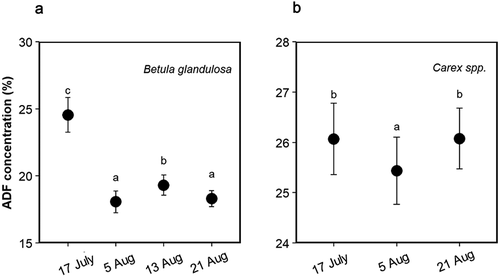
Figure 5. Acid detergent fibre (ADF) concentration (%) and 95% confidence intervals for Carex spp. for each experimental plot (n = 36) in the arctic tundra at Deception Bay, Nunavik, Canada. The analysis was performed using a linear mixed model with blocks (n = 9) and all interactions involving blocks as random factors. Predictions that share a common letter are not significantly different (Protected lsmeans, α = 0.05)
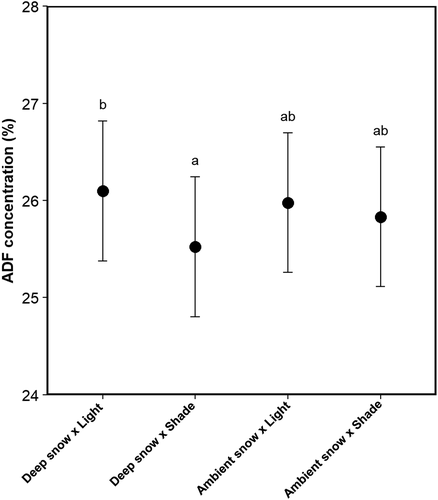
Figure 6. Number of leaf intercepts (proxy of foliar biomass) and 95% confidence intervals for B. glandulosa for each experimental subplot (n = 36) in the arctic tundra at Deception Bay, Nunavik, Canada. The analysis was performed using a linear mixed model with blocks (n = 9) and all interactions involving blocks as random factors. Predictions that share a common letter are not significantly different (Protected lsmeans, α = 0.05)
